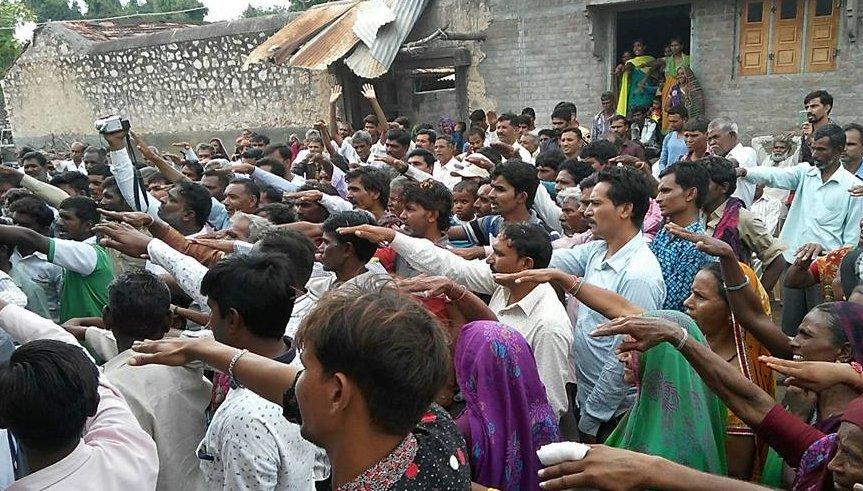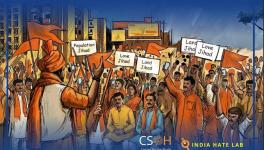The Una Dalit Struggle and What it Holds for the Future

Dalits of Sarangpur pledge to never dispose off dead cattle and come to Una on Aug 15 in huge numbers. Courtesy: Truth of Gujarat
The Una Incident and Growing Resistance
On July 11, 2016, four young Dalits were publicly flogged and paraded around in Una in broad daylight, for skinning a dead cow. The most inhuman kind of torture has been meted out to people on the pretext of cow protection, and the perpetrators in their bravado have uploaded the brutal acts on social media with impunity. Vigilante Hindutva groups acting in the name of cow protection clearly had no idea what they were getting into. Their actions sparked widespread protests in the state which transformed into a movement for Dalit rights. A movement that aspires to liberate Dalits from jobs like disposing of the carcasses of dead cattle and manual scavenging; and ensure land rights, alternative jobs and basic dignity of life. On July 31, at a Dalit Maha Sammelan in Ahmedabad, thousands of Dalits pledged to stop picking up carcasses and give up occupations like manual scavenging. It also led to the formation of the Una Dalit Atyachar Ladat Samiti to seek justice for the victims of the brutal attack in Una.
Shortly after, on August 5, the Dalit Asmita Yatra was flagged off from Ahmedabad and travelled over 400 kilometres through different villages of Gujarat. Pledges were taken in village after village to shun the traditional caste-based occupations of manual scavenging, cleaning sewer lines and skinning or disposing of dead cattle. The ten-day yatra culminated in the Azadi Kooch at Una on Independence Day. The Una protest and Dalit Asmita Rally are a historic response to attacks on Dalit lives, dignity and livelihood. They have seen an unprecedented unity of purpose with different individuals and progressive groups coming out in solidarity with this unique protest.
The Modani Model and Reality
Narendra Modi and his team have worked overtime to build the myth of a “Gujarat model” as one of inclusiveness, virtually an El Dorado – a place of fabulous wealth and opportunity. In reality what operates is what the people of Gujarat describe as the “Modani model”, with an abundance of opportunities for corporate loot at the expense of the masses. It also gives a free hand to communal and casteist forces for the unbridled implementation of their divisive Hindutva agenda. The Scheduled Castes or the Dalits make up 7.1% of the total population of Gujarat; among them, landlessness, unemployment and poverty are rampant. Lakhs of acres of land have been given to corporate houses like Adani, Ambani, Tata and the like, while the people continue to remain landless. There are more than 55,000 manual scavengers in Gujarat according to a study by the Navsarjan Trust.
What we saw on our trip to Una from Ahmedabad were signs of extreme poverty. A few of the Dalit children we spoke to mentioned that they faced extreme discrimination even at school, and were even forced to clean toilets. Very few Dalits had managed to find alternative employment and give up what they called traditionally imposed “dirty jobs”. Some of them reported that they were going to Mumbai, Kerala and even Lakshwadeep in search of menial jobs in painting, carpentry and in the construction sector, as life was much better there. There has been much hype about the “world class” roads of Gujarat. We found far too many potholes in the Modani model of development. It took us ten hours to cover the 350-kilometre distance from Ahmedabad to Una. Attacks on Muslims and Dalits by vigilante groups in the name of “gau raksha” (cow protection) have increased since the Narendra Modi-led BJP government assumed power at the centre. Incidents of public flogging, force-feeding cow-dung, stripping and parading Dalit victims have come to light. BJP governments, at the centre and in various states, have implicitly endorsed the violence by either refusing to take action against the culprits, or even explicitly glorifying them. Different Hindutva groups and vigilante “gau rakshaks” (cow protectors) are perpetrating such acts which dehumanise certain communities and are an assault on their basic dignity. "Sabka Saath Sabka Vikas" is a hollow slogan for the Dalits, who have not seen any improvement in their economic condition, only an increase in brutality and violence. It was the pent-up anger against growing oppression that we saw emerging in this Dalit movement.
The Dalit Asmita Rally
When we set out to Una as part of the Dalit Asmita Rally and the Azadi Kooch under the banner of the Una Dalit Atyachar Ladat Samiti, we were clear that it was an act of solidarity with a struggle led by the most oppressed sections of society. Solidarity actions to coincide with the Una programme were held in different states. On August 13 we heard reports that a bike rally seeking to mobilise for the Azadi Kooch was attacked by "upper-caste" Darbars at a village called Samter in Gir Somnath District. On August 14 the Dalit Asmita Rally had begun marching towards Una. We left from Una to join the rally but were stopped some way from Samter by a violent mob armed with weapons and stones which had blocked the road using vehicles and boulders. They also assaulted journalists from Dalit Camera and Two Circles.
It was a well-planned mobilisation seeking to disrupt the march. The police were mute spectators. Armed men in motorbikes and motorbike-drawn carts tried to create an atmosphere of fear. That evening, more reports reached us of attacks on people coming to the Azadi Kooch, some of whom had to be hospitalised. The threats and attacks by "gau rakshaks" only helped steel our resolve and bring more people into the streets in open defiance. The march reached Una by evening, taking an alternative route. We met the members at their camp and marched shoulder to shoulder in solidarity with them throughout Una. Dalit Shoshan Mukti Manch activists from Gujarat and Maharashtra were present in good numbers. We found that a few comrades from the Tamilnadu Untouchability Eradication Front and the Progressive Writers’ Association had come of their own initiative. The Students’ Federation of India was represented by a few activists from Gujarat and the Hyderabad Central University. Kisan Sabha, Trade Union and AIDWA representatives were also part of the march.
The march through Una raised spirits. Slogans of "Jai Bhim" and calls to fulfil the dreams of Babasaheb Ambedkar, and against Narendra Modi and the BJP government were raised. The most popular slogan, however, was “Keep the Cow’s Tail; Give Us Our Land”. The August 15 Azadi Kooch had an electrifying atmosphere. Thousands gathered in open defiance of all threats and attacks. Young Dalits and women formed the bulk of the mobilisation. The young leader of the movement, Jignesh Mevani, read out a pledge to give up occupations like disposing of cattle carcasses and manual scavenging, and demanded alternative employment as well as five acres of land to all Dalit families. He also called for a Rail Roko if the government failed to accede to the demand for land. Radhika Vemula, Rohith Vemula's mother, hoisted the tricolour and called for a struggle for Azadi from all kinds of oppression. JNUSU President Kanhaiya Kumar also addressed the meeting.
The villagers of Mota Samdhiyala, including the victims of the attack by "gau rakshaks", were forced to sit on a dharna at the Una Police Station, demanding action be taken against armed gangs threatening and attacking people. On Independence Day they sought protection to live in their villages and homes in peace. We interacted with the victims of the flogging and their families and could sense the pervasive feeling of fear. The culprits move around scot-free even as poor Dalit families are forced to live like refugees amidst intimidation and an atmosphere of fear. A Dalit leader alleged that his vehicle was fired at. Filmmaker Anand Patwardhan, a few journalists and I along with Vikram, General Secretary, SFI, and social activist Mujahid Nafees were present with them till they were escorted away under police protection. Later the "gau rakshaks" and Darbars attacked the Dalit protesters and destroyed some vehicles. As we crossed Samter, where opponents of the Una rally were concentrated, we could smell what seemed like teargas. Ambulances and police vehicles crisscrossed us with their sirens blaring. Numerous police personnel were reported injured in their attack and hospitalised. The armed goons stopped our bus looking for rally participants, but eventually let us pass. A little later the driver assured us we were in the "Safe Zone". All this on Independence Day!
What does Una hold for the future?
Is Una the Rosa Parks moment in the history of Dalit struggle against caste oppression? The answer is an emphatic “No”. The movement could well be much more if taken to its logical conclusion, as the issues involved are far-reaching. Rosa Parks transformed a single act of defiance into a defining moment for the modern American civil rights movement. Her act of defiance was against an unfair segregation law which forced black passengers to give up their seat to any white passenger who needed one. She was not the first to refuse: two other black women had previously been arrested on similar charges. Likewise in India, there have been protests against caste oppression and manual scavenging even before Una. However, by the sheer nature of what it seeks to overturn this movement could well inspire and spark off a nation-wide movement which could have an impact even more far-reaching than Rosa Parks's act of defiance. To realise its potential, it must seize the opportunity, and organise and rally around all progressive sections in solidarity with the struggle. Una could have a cascading impact and come to be counted among the historic struggles against caste oppression that have become part of folklore. History beckons us to build the broadest possible unity and take the message of Una to all parts of India, so as to organise and build a movement that will forever put an end to caste oppression.
First published in Bodhi Commons; republished here with minor changes.
Get the latest reports & analysis with people's perspective on Protests, movements & deep analytical videos, discussions of the current affairs in your Telegram app. Subscribe to NewsClick's Telegram channel & get Real-Time updates on stories, as they get published on our website.























